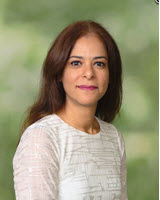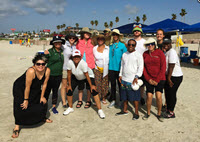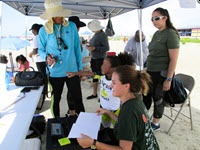
The Deepwater Horizon incident affected more than 1,700 km of Gulf of Mexico coastline. Chemical compounds from the oil spill posed a risk to human health, especially children whose play behaviors often bring them in direct contact with sand and water. To better understand these risks, researchers are quantifying how children play at the beach and combining those data with the different types and levels of oil spill compounds that reached shorelines.
Larissa Montas is developing an algorithm to predict the concentrations and distributions of oil compounds along beaches. Her novel algorithm will contribute to a larger risk assessment platform that assesses cumulative and aggregate risks to children’s health from oil spill compounds. These assessments can help inform future spill response decisions, including beach closures.
Larissa is a Ph.D. student with the University of Miami’s Civil, Architectural, and Environmental Engineering Department and a GoMRI Scholar with Beach Exposure And Child HEalth Study (BEACHES).
Her Path

Larissa describes science as her “first love” and can’t recall a time when she wasn’t involved with science in some way. Growing up in a seaside town, she created strong ties to the beach. The more she learned about beach ecosystems, the more her curiosity about environmental science deepened. Later, she completed undergraduate degrees in civil and environmental engineering and a master’s degree in environmental engineering at the University of Miami. While applying to doctoral programs, Larissa received an email from one of her previous professors, Dr. Helena Solo-Gabriele, advertising a graduate research opportunity with her lab. Larissa applied and joined Dr. Solo-Gabriele’s team investigating children’s health risks to oil spill compounds in beach environments.
“I am deeply interested in exploring the integrated relationship between the environment and human health, so our team’s research was a perfect match to my interests,” said Larissa. “Children’s environmental health is a topic close to my heart, as children are more vulnerable to environmental health issues.”
Her Work
Following Deepwater Horizon, responders and researchers collected tens of thousands of seawater, sediment, and atmospheric samples. The first phase of Larissa’s research was to sort this historical data. Using the General NOAA Operational Modeling Environment (GNOME)’s predicted timing of oil spill impacts, she categorized the data by time and space: impacted sites prior to oil impact, impacted sites after oil impact, and unimpacted sites. She also assisted efforts led by Dr. Alesia Ferguson to video record (with guardian permission) children’s beach play activities and patterns to characterize children’s interactions with sand and other potential sources of oil contamination. She is currently developing an algorithm that will utilize a fate and transport model’s outputs for future predictions of concentrations of individual toxic oil compounds that might reach nearshore waters and sand.
The second phase of Larissa’s research focuses on analyzing oil compounds associated with Deepwater Horizon that were identified as toxic. Using an oil spill fate and transport model, she tracks how long it will take each compound to reach the beach environment. Then, she incorporates existing data about the compound’s physical and chemical properties to predict how much it should be degraded when it reaches the nearshore environment. “Some of the oil compounds won’t get there at all because they will be completely degraded or become airborne before arrival,” explained Larissa. “But, most of them will, and we need to know how much and what health risks are associated with those concentrations.” She uses her results to generate concentration-frequency distributions, a type of histogram that represents how often a measured concentration falls within a certain range in sand/marsh sediment, water, and tar. She then compares concentration ratios of the different compounds to the original source oil to identify changes in the oil’s overall composition by the time it reaches the beach environment.

The third phase of Larissa’s research uses atmospheric remote sensing to estimate the impacts of toxic airborne compounds associated with Deepwater Horizon on beach environments. She assists Dr. Naresh Kumar to assess changes in remotely-sensed parameters immediately before and after the spill, collocated with meteorological conditions and adjusted using region specific regression. Using this approach, researchers can develop beach-specific concentrations of airborne compounds for future oil spill exposure studies.
Larissa’s research will contribute to an assessment platform providing health risk information for children swimming or playing at oil-impacted beaches. “Children’s behavioral patterns make them more vulnerable than adults, and they have more-intimate contact with the sand due to play activities such as burying themselves in the sand,” said Larissa. “Our risk assessment platform aims to help improve estimations about children’s exposures and risks to toxic oil compounds and inform decision makers and first responders about toxic compound concentrations when an oil slick approaches the nearshore environment.”
Her Learning
Working with Dr. Solo-Gabriele taught Larissa that the rigorous scientific process can also be an exciting, creative, and collaborative process. One of Larissa’s favorite memories was assisting with fieldwork that quantified children’s beach play activities. The team worked from early morning to late evening collecting data on over 100 children playing at four beaches in Florida and Texas. “The whole BEACHES team came together, and the PIs worked hard side-by-side with the students,” said Larissa. “It was collaboration at its best and gave me the opportunity to learn about the work that Co-PIs Dr. Alicia Ferguson and Dr. Kristi Mena are leading.”
Larissa’s journey has shown her that exploring different fields and seeking guidance from mentors are important goals for students considering a scientific career. “Students’ motivations are as varied as they are as individuals,” she said. “A good way to start is to take initiative and volunteer for a project that matches your interests. Many professors like giving advice. Don’t be afraid to seek out mentors who can help you understand where to take that first step.”
After graduating, Larissa wants to continue interdisciplinary research investigating environmental contaminants and human health.
Praise for Larissa
Dr. Solo-Gabriele said that Larissa was at the top of her list when recruiting graduate students for her GoMRI project. She described Larissa as having “an engineering mind,” praising her methodical approach to research and detailed-oriented personality. She explained that Larissa’s laboratory experience gave her an advantage when analyzing the complex chemical composition of oil in air, water, and sediments. “She understands the details of the analytical techniques and the difficulties that may occur when trying to compare the results from different laboratories,” said Dr. Solo-Gabriele. “Larissa has submitted a peer-reviewed journal article [based on her research] that provides insight to the natural background concentrations of oil spill compounds, which is useful for identifying the excess risks associated with oil spill impacts along coastal regions.”
The GoMRI community embraces bright and dedicated students like Larissa Montas and their important contributions. The GoMRI Scholars Program recognizes graduate students whose work focuses on GoMRI-funded projects and builds community for the next generation of ocean science professionals.
By Stephanie Ellis and Nilde Maggie Dannreuther. Contact sellis@ngi.msstate.edu for questions or comments.
************
The Gulf of Mexico Research Initiative (GoMRI) is a 10-year independent research program established to study the effect, and the potential associated impact, of hydrocarbon releases on the environment and public health, as well as to develop improved spill mitigation, oil detection, characterization and remediation technologies. An independent and academic 20-member Research Board makes the funding and research direction decisions to ensure the intellectual quality, effectiveness and academic independence of the GoMRI research. All research data, findings and publications will be made publicly available. The program was established through a $500 million financial commitment from BP. For more information, visit http://gulfresearchinitiative.org/.
© Copyright 2010-2019 Gulf of Mexico Research Initiative (GoMRI) – All Rights Reserved. Redistribution is encouraged with acknowledgement to the Gulf of Mexico Research Initiative (GoMRI). Please credit images and/or videos as done in each article. Questions? Contact web-content editor Nilde “Maggie” Dannreuther, Northern Gulf Institute, Mississippi State University (maggied@ngi.msstate.edu).
